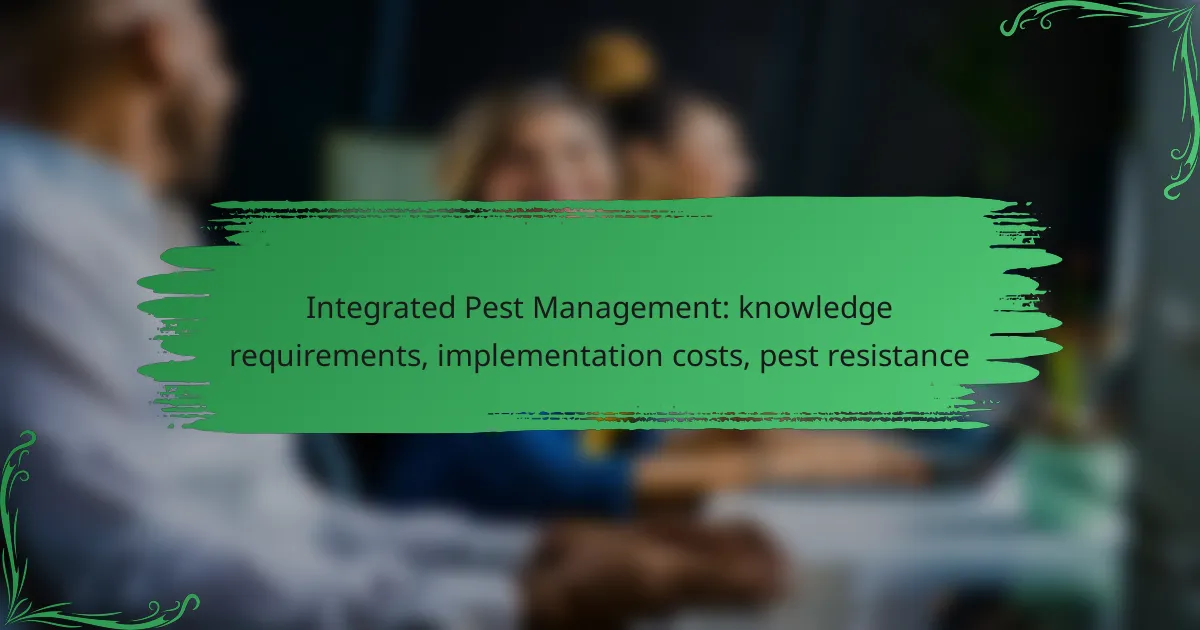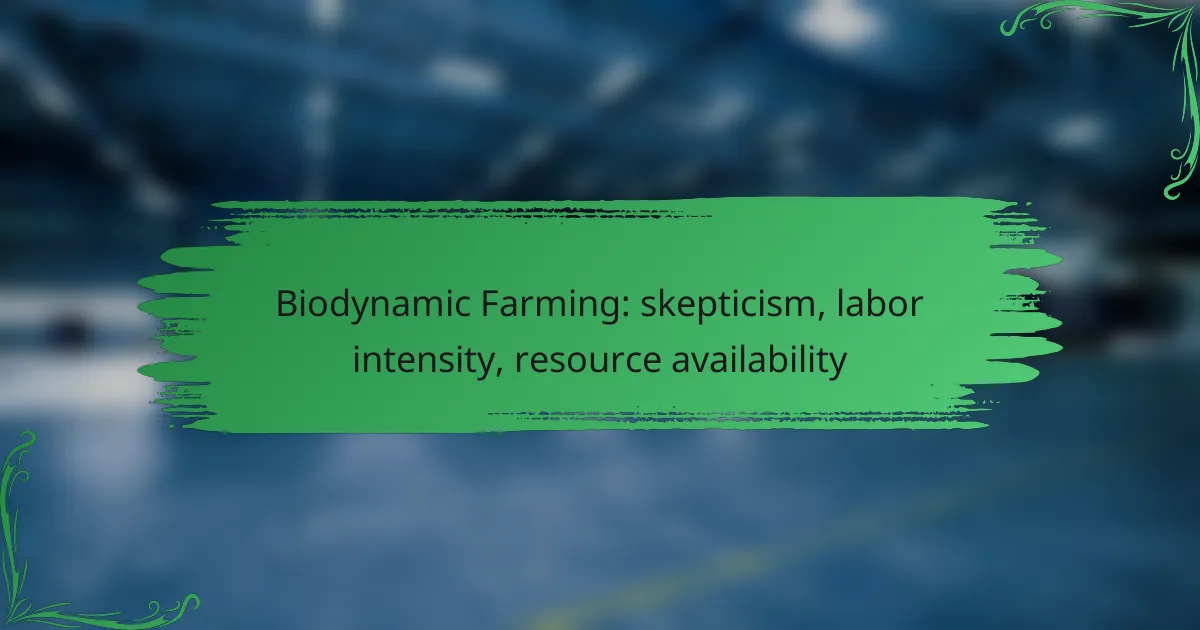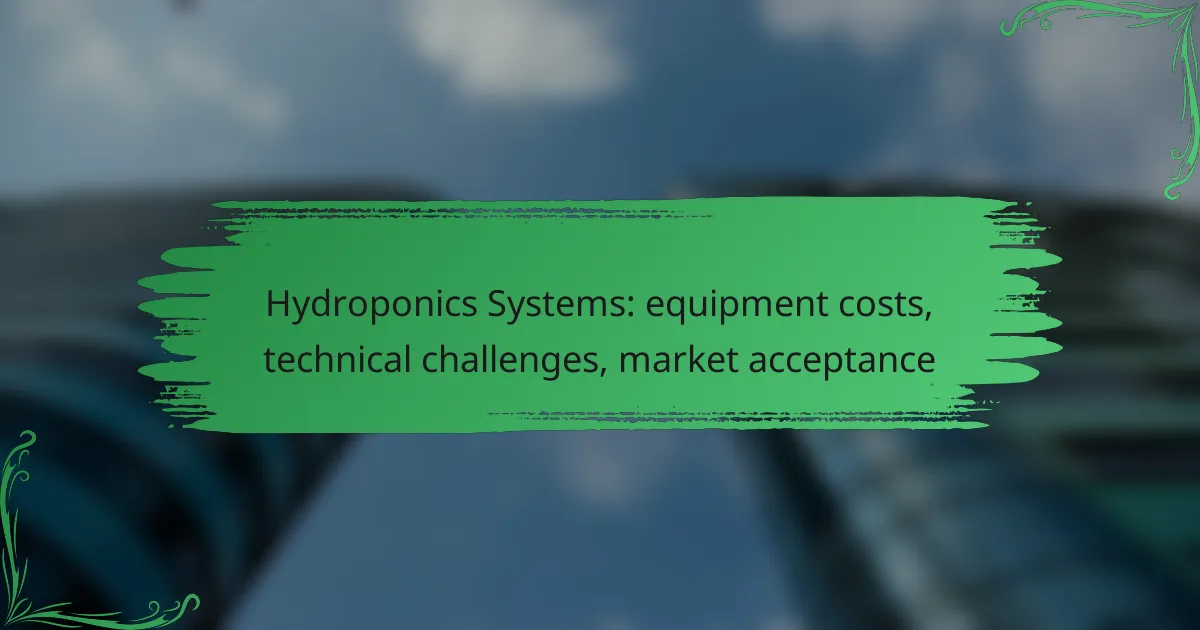Integrated Pest Management (IPM) is a holistic approach that integrates various strategies to control pest populations while safeguarding human health and the environment. By utilizing methods such as biological control, cultural practices, and targeted pesticide use, IPM aims to minimize risks and costs associated with pest management. Understanding the knowledge requirements and implementation costs is essential for effective IPM, particularly in urban settings where pest resistance can complicate control efforts.
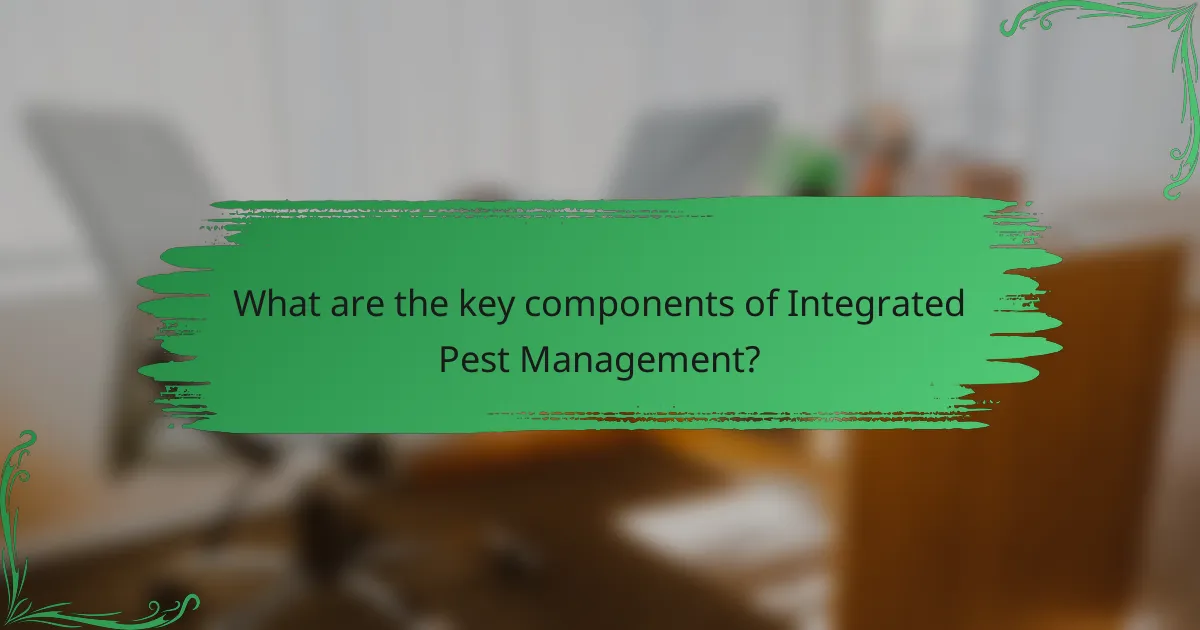
What are the key components of Integrated Pest Management?
Integrated Pest Management (IPM) combines various strategies to manage pest populations effectively while minimizing risks to human health and the environment. The key components include biological control, cultural practices, mechanical controls, pesticide use, and monitoring and assessment.
Biological control methods
Biological control methods involve using natural predators, parasites, or pathogens to manage pest populations. For instance, introducing ladybugs can help control aphid infestations in gardens. This approach reduces reliance on chemical pesticides and promotes ecological balance.
When implementing biological controls, consider the compatibility of the introduced species with the local ecosystem. It’s essential to monitor their effectiveness and adjust strategies as needed to ensure they thrive and effectively suppress pest populations.
Cultural practices
Cultural practices focus on modifying farming or gardening techniques to reduce pest establishment and reproduction. Crop rotation, intercropping, and proper sanitation are common examples. These practices can disrupt pest life cycles and create unfavorable conditions for their survival.
Implementing cultural practices requires understanding the specific pests in your area and adapting your methods accordingly. For example, rotating crops annually can significantly reduce soil-borne pests and diseases.
Mechanical controls
Mechanical controls involve physical methods to manage pests, such as traps, barriers, and hand-picking. Using row covers can protect seedlings from insects, while sticky traps can monitor pest populations. These methods are often labor-intensive but can be highly effective in small-scale settings.
Consider the scale of your operation when choosing mechanical controls. For larger areas, investing in automated traps or barriers may be more efficient, while smaller gardens can benefit from manual methods.
Pesticide use
Pesticide use in IPM is strategic and targeted, focusing on the most effective products with the least environmental impact. Selective pesticides can be used to minimize harm to beneficial organisms. Always follow local regulations and guidelines when applying pesticides to ensure safety and compliance.
It’s crucial to integrate pesticide use with other IPM components to avoid developing pest resistance. Rotate different classes of pesticides and apply them only when monitoring indicates a need to maintain effectiveness.
Monitoring and assessment
Monitoring and assessment are vital for evaluating pest populations and the effectiveness of your IPM strategies. Regular inspections and data collection help identify pest trends and inform decision-making. Utilize tools like pest traps and scouting reports to gather accurate information.
Establish a monitoring schedule that aligns with pest life cycles and seasonal changes. This proactive approach allows for timely interventions, reducing the need for more drastic measures later on.
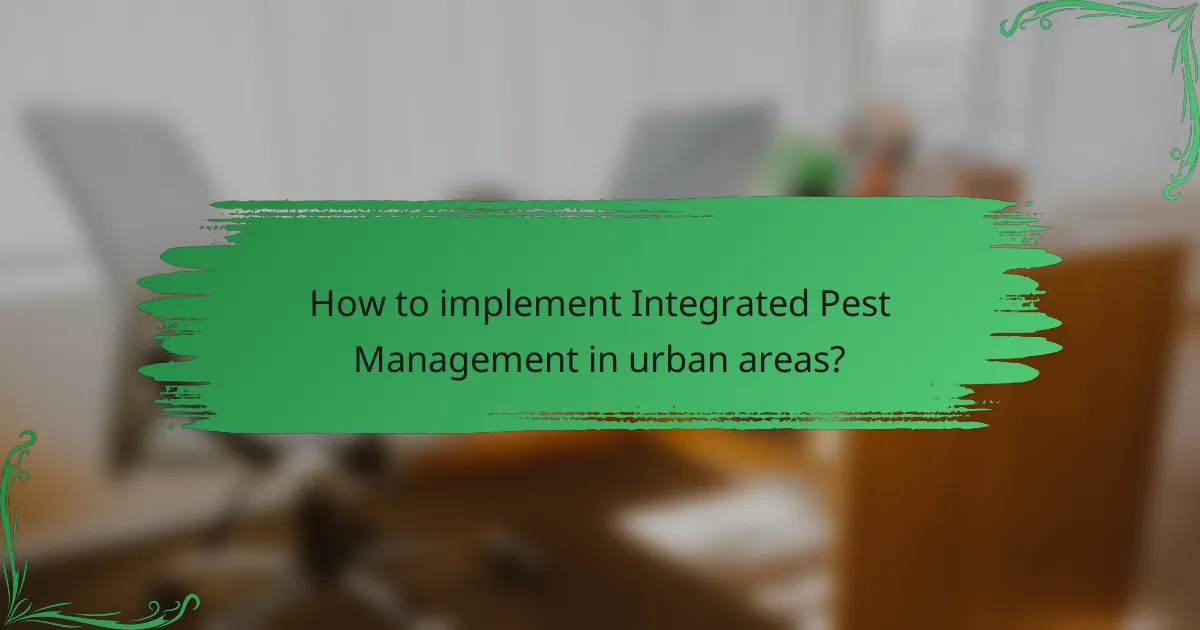
How to implement Integrated Pest Management in urban areas?
Implementing Integrated Pest Management (IPM) in urban areas involves a systematic approach to controlling pests while minimizing risks to human health and the environment. Key steps include monitoring pest populations, identifying pest species, and applying targeted control measures based on thresholds.
Step-by-step implementation guide
Begin by conducting a thorough assessment of the urban environment to identify potential pest issues. This includes inspecting buildings, landscapes, and public spaces for signs of pest activity. Next, establish monitoring systems to track pest populations and determine when intervention is necessary.
Once monitoring is in place, identify the specific pests and evaluate their life cycles and behaviors. This knowledge will inform the selection of appropriate control methods, which may include cultural practices, biological controls, or chemical treatments. Always prioritize non-chemical methods when possible.
Finally, implement the chosen control strategies and evaluate their effectiveness regularly. Adjust your approach based on the results to improve pest management outcomes over time.
Community involvement strategies
Engaging the community is crucial for the success of IPM in urban settings. Start by educating residents about pest identification and prevention techniques, such as proper waste disposal and landscaping choices that deter pests. Workshops and informational sessions can be effective tools for raising awareness.
Encourage community participation in monitoring efforts by establishing volunteer programs where residents can report pest sightings or participate in surveys. This not only helps gather valuable data but also fosters a sense of ownership and responsibility among community members.
Consider forming partnerships with local organizations, schools, and businesses to promote IPM practices. Collaborative efforts can amplify outreach and create a more pest-aware community.
Local pest control regulations
Urban areas often have specific regulations governing pest control practices to protect public health and the environment. Familiarize yourself with local laws regarding pesticide use, application methods, and reporting requirements. Many municipalities require licensed professionals for certain pest control measures.
Check for any restrictions on the types of chemicals that can be used, particularly in sensitive areas such as schools, parks, and residential neighborhoods. Compliance with these regulations is essential to avoid fines and ensure community safety.
Stay informed about any changes in local pest control regulations, as these can impact your IPM strategies. Regularly consult local government websites or pest management associations for updates and resources.

What are the costs associated with Integrated Pest Management?
The costs associated with Integrated Pest Management (IPM) can vary significantly based on the specific practices implemented and the scale of the operation. Generally, these costs can be categorized into initial setup expenses and ongoing maintenance costs, both of which are crucial for effective pest control.
Initial setup costs
Initial setup costs for IPM can include expenses for soil testing, pest monitoring equipment, and training for staff. Depending on the complexity of the IPM program, these costs may range from a few hundred to several thousand dollars. For example, purchasing traps and sensors for monitoring pests can add up quickly, especially for larger agricultural operations.
Additionally, implementing cultural practices, such as crop rotation or selecting pest-resistant plant varieties, may require upfront investments in seeds or soil amendments. It’s essential to budget for these initial costs to ensure a successful IPM strategy.
Ongoing maintenance expenses
Ongoing maintenance expenses in an IPM program typically include costs for regular monitoring, pest control interventions, and staff training updates. Monitoring can involve periodic soil and plant inspections, which may require hiring specialists or purchasing additional equipment. These costs can accumulate over time, potentially reaching hundreds of dollars monthly.
Furthermore, maintaining pest-resistant varieties or applying biological controls may incur additional costs. It’s important to consider these ongoing expenses when evaluating the overall financial commitment to an IPM program.
Cost-benefit analysis
A cost-benefit analysis for IPM should weigh the initial and ongoing costs against the potential savings from reduced pesticide use and increased crop yields. While the upfront investment may seem significant, many farmers find that IPM leads to long-term savings by minimizing chemical inputs and enhancing ecosystem health.
To conduct a thorough analysis, consider tracking pest populations, crop health, and yield data over time. This information can help determine the effectiveness of the IPM strategies employed and justify the investment. Ultimately, a well-implemented IPM program can lead to improved profitability and sustainability in agricultural practices.
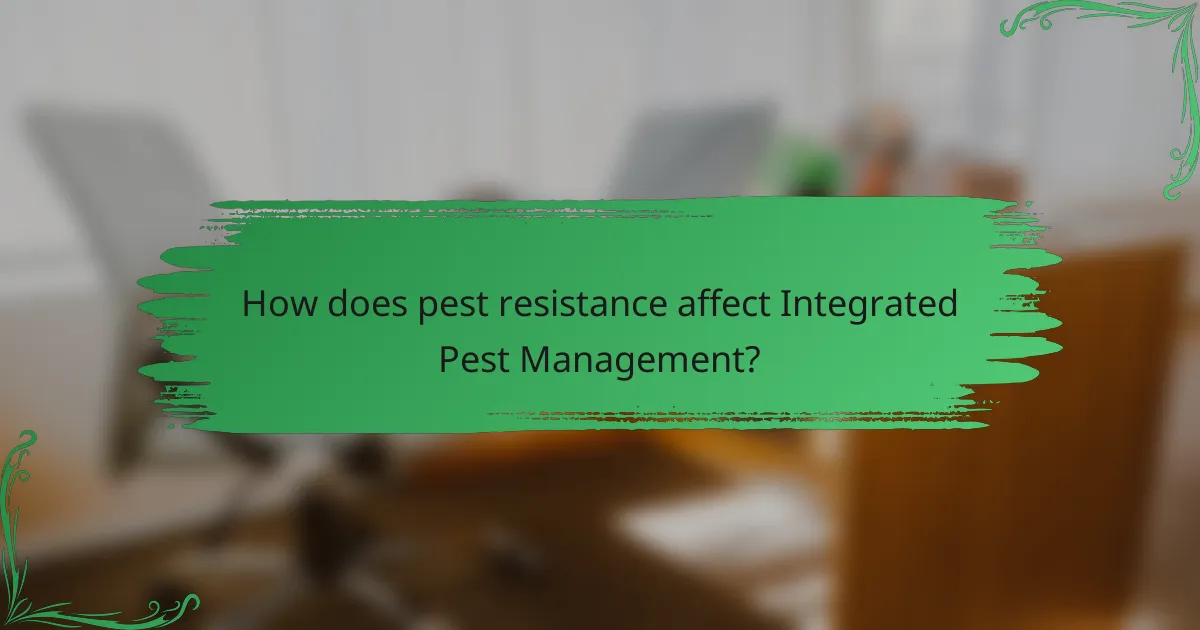
How does pest resistance affect Integrated Pest Management?
Pest resistance significantly impacts Integrated Pest Management (IPM) by reducing the effectiveness of control measures. When pests develop resistance to pesticides or other control methods, it can lead to increased pest populations and higher management costs.
Types of pest resistance
Pest resistance can be categorized into several types, including genetic resistance, behavioral resistance, and physiological resistance. Genetic resistance occurs when pests inherit traits that allow them to survive pesticide applications. Behavioral resistance involves changes in pest behavior that reduce exposure to control measures, while physiological resistance refers to internal adaptations that enable pests to tolerate or detoxify pesticides.
Impact on pest control strategies
The emergence of pest resistance necessitates adjustments in pest control strategies. Farmers may need to rotate different classes of pesticides or integrate non-chemical methods to manage resistant populations effectively. This can lead to increased costs and complexity in planning and implementing pest management programs, as reliance on a single control method becomes less viable.
Resistance management practices
To manage resistance effectively, practitioners should adopt a variety of resistance management practices. These include using integrated approaches that combine biological, cultural, and chemical controls, as well as monitoring pest populations to detect resistance early. Implementing strategies such as refuge planting, which involves growing non-Bt crops alongside Bt crops, can help maintain susceptibility in pest populations. Regular training and education on resistance management are also crucial for ensuring that all stakeholders are informed and equipped to adapt their practices.
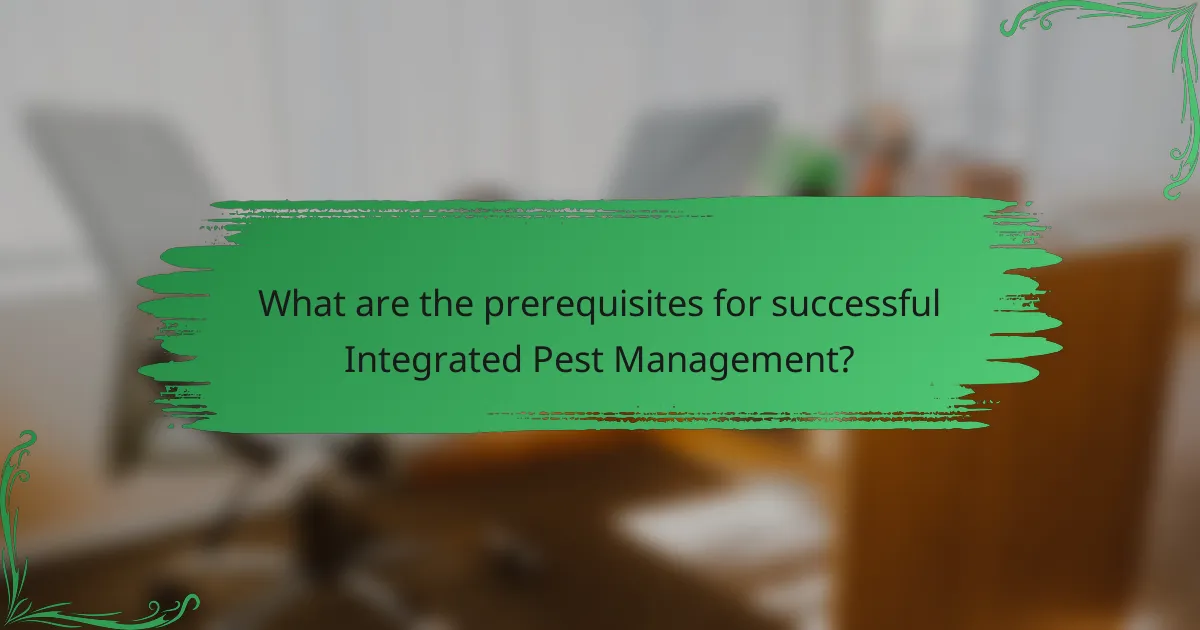
What are the prerequisites for successful Integrated Pest Management?
Successful Integrated Pest Management (IPM) requires a solid understanding of pest biology, ecology, and management strategies. Additionally, effective implementation hinges on collaboration among stakeholders and ongoing education to adapt to evolving pest challenges.
Knowledge and training requirements
To implement IPM effectively, individuals must possess knowledge of pest identification, life cycles, and ecological interactions. Training programs often cover integrated approaches, including biological control, cultural practices, and the judicious use of pesticides.
Practical experience is invaluable; hands-on training can help practitioners recognize pest thresholds and determine appropriate management actions. Familiarity with local regulations regarding pesticide use and environmental impact is also essential.
Stakeholder engagement
Engaging stakeholders is crucial for the success of IPM initiatives. This includes farmers, agricultural advisors, researchers, and community members who can provide insights and support for pest management strategies. Regular communication fosters collaboration and encourages the sharing of best practices.
Organizing workshops and field days can enhance stakeholder involvement, allowing participants to learn from each other and discuss challenges. Building a network of local experts can also facilitate knowledge exchange and promote sustainable pest management solutions tailored to specific environments.
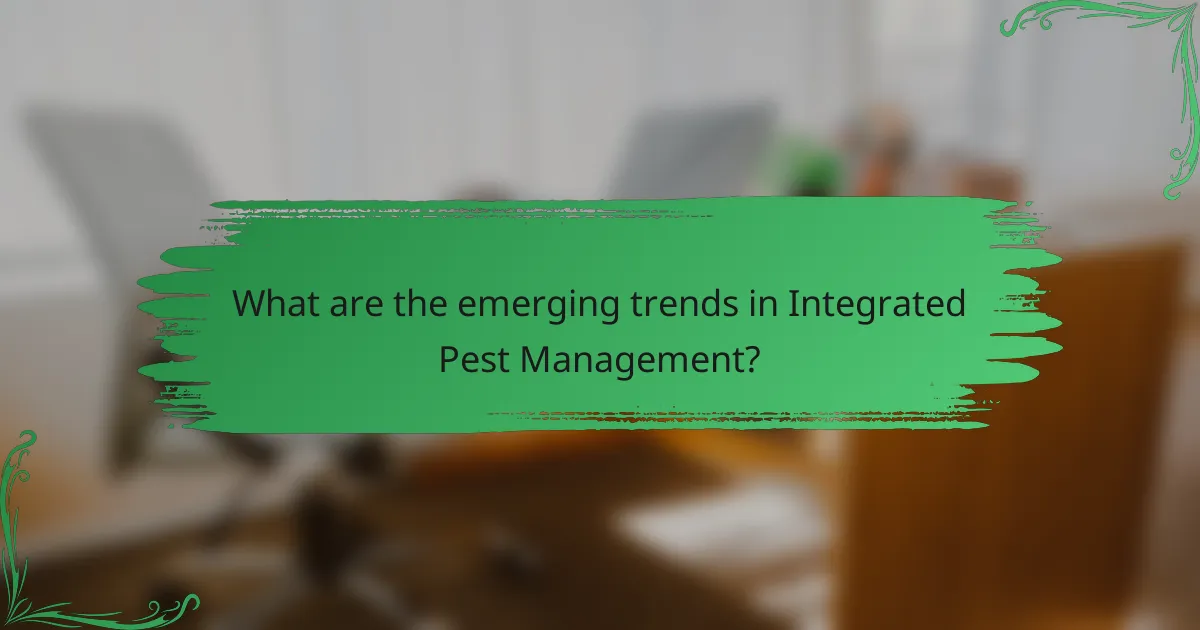
What are the emerging trends in Integrated Pest Management?
Emerging trends in Integrated Pest Management (IPM) focus on innovative practices that enhance pest control while minimizing environmental impact. Key developments include the adoption of advanced technologies and evolving regulatory frameworks that shape pest management strategies.
Technological advancements
Technological advancements are transforming Integrated Pest Management by introducing precision agriculture tools, such as drones and sensors. These technologies enable farmers to monitor pest populations and crop health in real-time, allowing for targeted interventions that reduce pesticide use.
Additionally, data analytics and machine learning are being utilized to predict pest outbreaks and optimize treatment schedules. For instance, predictive models can analyze weather patterns and historical data to forecast pest activity, helping farmers make informed decisions.
Regulatory changes
Regulatory changes are increasingly influencing Integrated Pest Management practices, with a focus on sustainability and safety. Governments are implementing stricter guidelines on pesticide usage, promoting the adoption of environmentally friendly alternatives.
Farmers must stay informed about local regulations, which may include restrictions on certain chemicals or requirements for pesticide application. Engaging with local agricultural extension services can provide valuable insights into compliance and best practices for sustainable pest management.
